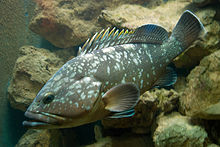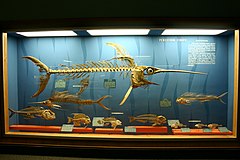Perciformes
| Perciformes Temporal range: | |
|---|---|
 | |
| Dusky grouper (Epinephelus marginatus) | |
| Scientific classification | |
| Domain: | Eukaryota |
| Kingdom: | Animalia |
| Phylum: | Chordata |
| Class: | Actinopterygii |
| Clade: | Percomorpha |
| Order: | Perciformes Bleeker, 1863 |
| Type species | |
| Perca fluviatilis Linnaeus, 1758 | |
| Suborders | |
| See text | |
Perciformes (/ˈpɜːrsɪˌfɔːrmiːz/), also called the Acanthopteri, is an order or superorder of ray-finned fish in the clade Percomorpha. Perciformes means "perch-like". Among the well-known members of this group are perch and darters (Percidae), sea bass and groupers (Serranidae).[1]
Taxonomy[edit]
Formerly, this group was thought to be even more diverse than it is thought to be now, containing about 41% of all bony fish (about 10,000 species) and about 160 families, which is the most of any order within the vertebrates.[2] However, many of these other families have since been reclassified within their own orders within the clade Percomorpha, significantly reducing the size of the group. In contrast to this splitting, other groups formerly considered distinct, such as the Scorpaeniformes, are now classified in the Perciformes.[3]
Evolution[edit]
The earliest fossil perciform is the extinct serranid Paleoserranus from the Early Paleocene of Mexico, but potential records of "percoids" are known from the Maastrichtian, including Eoserranus, Indiaichthys, and Prolates, although their exact taxonomic identity remains uncertain.[4][5]
Characteristics[edit]
The dorsal and anal fins are divided into anterior spiny and posterior soft-rayed portions, which may be partially or completely separated. The pelvic fins usually have one spine and up to five soft rays, positioned unusually far forward under the chin or under the belly. Scales are usually ctenoid (rough to the touch), although sometimes they are cycloid (smooth to the touch) or otherwise modified.
Taxonomy[edit]
Classification of this group is controversial. As traditionally defined before the introduction of cladistics, the Perciformes are almost certainly paraphyletic. Other orders that should possibly be included as suborders are the Scorpaeniformes, Tetraodontiformes, and Pleuronectiformes. Of the presently recognized suborders, several may be paraphyletic, as well. These are grouped by suborder/superfamily, generally following the text Fishes of the World.[2][6][7][8]


|
References[edit]
- ^ "Perciform - Form and function". Encyclopedia Britannica. Retrieved 14 February 2019.
- ^ a b Nelson, J. S. (2006). Fishes of the World (4 ed.). Hoboken, NJ: John Wiley & Sons. ISBN 978-0-471-25031-9.
- ^ J. S. Nelson; T. C. Grande; M. V. H. Wilson (2016). Fishes of the World (5th ed.). Wiley. pp. 497–502. ISBN 978-1-118-34233-6. Archived from the original on 8 April 2019. Retrieved 24 December 2020.
- ^ Cantalice, Kleyton M.; Alvarado-Ortega, Jesús; Alaniz-Galvan, Abril (1 April 2018). "Paleoserranus lakamhae gen. et sp. nov., a Paleocene seabass (Perciformes: Serranidae) from Palenque, Chiapas, southeastern Mexico". Journal of South American Earth Sciences. 83: 137–146. doi:10.1016/j.jsames.2018.01.010. ISSN 0895-9811.
- ^ Kriwet, Jürgen; Arratia, Gloria; López-Arbarello, Adriana; Parmar, Varun; Prasad, Guntupalli (1 January 2004). "Late Cretaceous-Paleocene percomorphs (Teleostei) from India - early radiation of perciformes". Recent advances in ….
- ^ Froese, Rainer, and Daniel Pauly, eds. (2015). "Perciformes" in FishBase. August 2015 version.
- ^ "ADW: Perciformes". animaldiversity.ummz.umich.edu. Animal Diversity Web.
- ^ a b J. S. Nelson; T. C. Grande; M. V. H. Wilson (2016). Fishes of the World (5th ed.). Wiley. pp. 430–467. ISBN 978-1-118-34233-6. Archived from the original on 8 April 2019. Retrieved 20 February 2020.
- ^ Betancur-R, Ricardo; Wiley, Edward O.; Arratia, Gloria; Acero, Arturo; Bailly, Nicolas; Miya, Masaki; Lecointre, Guillaume; Ortí, Guillermo (6 July 2017). "Phylogenetic classification of bony fishes". BMC Evolutionary Biology. 17 (1): 162. doi:10.1186/s12862-017-0958-3. ISSN 1471-2148. PMC 5501477. PMID 28683774.


 French
French Deutsch
Deutsch